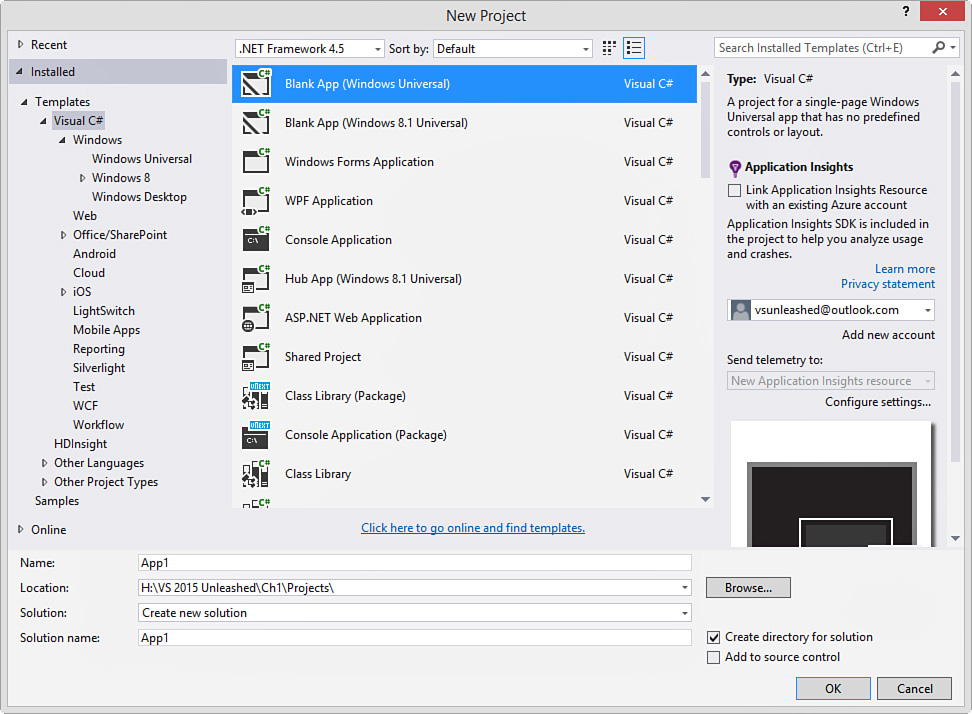 The Many Faces of a .NET Application
by Mike Snell, Lars Powers
Microsoft Visual Studio 2015 Unleashed, Third Edition
The Many Faces of a .NET Application
by Mike Snell, Lars Powers
Microsoft Visual Studio 2015 Unleashed, Third Edition
- About This eBook
- Title Page
- Copyright Page
- Contents at a Glance
- Table of Contents
- About the Authors
- Dedication
- Acknowledgments
- We Want to Hear from You!
- Reader Services
- Introduction
- Part I: Introducing Visual Studio 2015
- Chapter 1. A Quick Tour of Visual Studio 2015
- Chapter 2. The Visual Studio IDE
- Chapter 3. The .NET Languages
- What’s New in C# 6.0 and VB 14
- Language Primer
- Language Features
- Infer a Variable’s Data Type Based on Assignment
- Create an Object and Initialize Its Values (Object Initializers)
- Define a Collection and Initialize Its Values
- Creating an Instance of a Nonexistent Class
- Add Methods to Existing Classes (Extension Methods)
- Add Business Logic to Generated Code (Partial Methods)
- Access and Query Data Using the .NET Languages
- Write Simple Unnamed Functions Within Your Code (Lambda Expressions)
- Splitting an Assembly Across Multiple Files
- Working with XML Directly Within Your Code (VB Only)
- Removing Unused Arguments from Event Handlers (VB Only)
- Creating an Automatically Implemented Property
- Dropping the Underscore in VB for Line Continuation
- Working with Dynamic Languages/Objects
- Covariance and Contravariance
- Asynchronous Programming
- The .NET Framework
- Summary
- Part II: An In-Depth Look at the IDE
- Chapter 4. Solutions and Projects
- Chapter 5. Browsers and Explorers
- Chapter 6. Introducing the Editors and Designers
- Part III: Working with the Visual Studio Tools
- Chapter 7. Working with Visual Studio’s Productivity Aids
- Chapter 8. Testing Code
- Chapter 9. Refactoring Code
- Chapter 10. Debugging Code
- Chapter 11. Deploying Code
- Chapter 12. Developing Applications in the Cloud with Windows Azure
- Chapter 13. Working with Databases
- Part IV: Extending Visual Studio
- Part V: Building Web Applications
- Chapter 17. Building Modern Websites with ASP.NET 5
- Chapter 18. Using JavaScript and Client-Side Frameworks
- Chapter 19. Building and Consuming Services with Web API and WCF
- Part VI: Building Windows Client Apps
- Chapter 20. Building Windows Forms Applications
- Chapter 21. Building WPF Applications
- Chapter 22. Developing Office Business Applications
- Part VII: Creating Mobile Apps
- Chapter 23. Developing Windows Store Applications
- Chapter 24. Creating Windows Phone Applications
- Chapter 25. Writing Cross-Platform Mobile Applications with Apache Cordova
- Index
- Code Snippets
The Many Faces of a .NET Application
.NET has become the standard when building applications targeting the Microsoft Windows client, server products, Windows Phone, Windows Store apps, websites, and more. Windows programming and .NET programming are now synonymous.
Many of the user applications we interact with have some if not all of their code base in .NET. This includes rich clients built on Windows, solutions built on Office (including parts of Office itself), mobile apps that also work with web services, web applications that run in a browser and execute on a Windows server, product extension solutions such as those written for SharePoint and BizTalk, and Windows Store applications targeting Windows 8/10.
The good news is that the .NET developer is in high demand, and you can leverage your skills to target a wide audience across an array of user experiences.
Figure 1.1 shows the New Project dialog in Visual Studio; it serves as an example of the myriad user solutions that are possible with .NET. This graphic cannot fit all the possibilities available to you, but it does illustrate that Windows, web, Office, and many other project types are within the reach of .NET developers working with Visual Studio.
As discussed, you have many project templates available for your next solution. What is needed, however, is some sort of road map with respect to user experience. Choosing the right project template is an important part of making the delivery of your solution successful. The following is a high-level overview of the core presentation technologies available to the .NET developer. (There are more, but these are the common ones.)
Note
Visual Studio provides many UI platform options. Many are highlighted here; for in-depth coverage, see their specific chapters in this book: Chapter 17, “Building Modern Websites with ASP.NET 5,” Chapter 18, “Using JavaScript and Client-Side Frameworks,” Chapter 20, “Building Windows Forms Applications,” Chapter 21, “Building WPF Applications,” Chapter 22, “Developing Office Business Applications,” Chapter 23, “Developing Windows Store Applications,” Chapter 24, “Creating Windows Phone Applications,” and Chapter 25, “Writing Cross-Platform Mobile Applications with Apache Cordova.”
-
No Comment
